Classification Evaluation and Genetic Analysis of Source Rocks of Lower Permian Fengcheng Formation in Hashan Area, Junggar Basin, China
Abstract
1. Introduction
2. Geological Setting
3. Samples and Experiments
3.1. Samples
3.2. Experimental Methods
4. Lithofacies Division
5. Quality of Source Rocks
5.1. Organic Matter Richness
5.2. Types of Organic Matter
5.3. Maturity of Organic Matter
6. Analysis of the Factors Influencing Source Rock Quality
6.1. Sedimentary Environment
6.1.1. Paleoenvironment
6.1.2. Alkaline Minerals and Volcanism
6.2. Biological Origins of Source Rocks and Their Hydrocarbon-Generating Properties
6.2.1. Biological Origin of Source Rocks
6.2.2. Analysis of the Differences in Hydrocarbon Generation Performance of Source Rocks with Different Biological Origins
6.3. Maturity
7. Conclusions
Author Contributions
Funding
Data Availability Statement
Conflicts of Interest
References
- Carroll, A.R.; Bohacs, K.M. Lake-type controls on petroleum source rock potential in nonmarine basins. Am. Assoc. Pet. Geol. 2001, 85, 1033–1053. [Google Scholar]
- Katz, B.J. Significance of ODP results on deepwater hydrocarbon exploration—Eastern equatorial Atlantic region. J. Afr. Earth Sci. 2006, 46, 331–345. [Google Scholar] [CrossRef]
- Warren, J.K. Evaporites: A Geological Compendium; Springer: Berlin/Heidelberg, Germany, 2016. [Google Scholar]
- Cao, J.; Lei, D.; Li, Y.; Tang, Y.; Chang, Q.; Abulimit, W.T. Ancient high-quality alkaline lacustrine source rocks discovered in the Lower Permian Fengcheng Formation, Junggar Basin. Acta Pet. Sin. 2015, 36, 781–790. [Google Scholar]
- Jin, Q.; Huang, X.H. Studies on origin of the early tertiary salt lake Dongpu Depression—A postulated deep water model. East China Pet. J. 1985, 9, 1–11. [Google Scholar]
- Jiang, J.G.; Guo, S.Y.; Fu, J.M. Discovery of immature high sulfur crude oil and its significance in gypsum salt bearing sedimentary basin. Exp. Pet. Geol. 1988, 10, 337–343. [Google Scholar]
- Horsfield, B.; Curry, D.; Bohacs, K.; Littke, R.; Rullkötter, J.; Schenk, H.; Radke, M.; Schaefer, R.; Carroll, A.; Isaksen, G.; et al. Organic geochemistry of freshwater and alkaline lacustrine sediments in the Green River Formation of the Washakie Basin, Wyoming, USA. Org. Geochem. 1994, 22, 415–440. [Google Scholar] [CrossRef]
- Ruble, T.E.; Lewan, M.D.; Philp, R.P. New insights on the Green River petroleum system in the Uinta basin from hydrous pyrolysis experiments. Am. Assoc. Pet. Geol. Bull. 2001, 85, 1333–1371. [Google Scholar] [CrossRef]
- Francavilla, M.; Kamaterou, P.; Intini, S.; Monteleone, M.; Zabaniotou, A. Cascading microalgae biorefinery: First pyrolysis of Dunaliellatertiolecta lipid extracted-residue. Algal Res. 2015, 11, 184–193. [Google Scholar] [CrossRef]
- Rüdiger, W. Chlorophyll metabolism: From outer space down to the molecular level. Phytochemistry 1997, 7, 1151–1167. [Google Scholar] [CrossRef]
- Peters, K.E.; Walters, C.C.; Moldowan, J.M. The Biomarker Guide: Biomarkers and Isotopes in the Environment and Human History; Cambridge University Press: Cambridge, UK, 2005; p. 1155. [Google Scholar]
- Yu, K.; Cao, Y.; Qiu, L.; Sun, P. Depositional environments in an arid, closed basin and their implications for oil and gas exploration: The lower Permian Fengcheng Formation in the Junggar Basin, China. Aapg Bull. 2019, 103, 2073–2115. [Google Scholar] [CrossRef]
- Zhang, K.; Sun, Z.; Zhang, G.; Song, Z.; Yu, H.; Zhou, J.; Cao, T.; Song, M.; Wang, B.; Li, Z. Shale lithofacies and shale oil enrichment model of Fengcheng Formation in Hashan area, Junggar Basin. Pet. Geol. Exp. 2023, 45, 593–605. [Google Scholar]
- Liu, H.M.; Wen, H.G.; Zhang, K.H.; Guo, P.; Zhang, G.L.; Yu, H.Z.; Xiong, W.; Zhou, J.; Xu, W.L.; Song, M.Y.; et al. Geological characteristics and exploration prospects of alkaline lake shale oil of Fengcheng Formation, Hashan area, NW Junggar Basin. J. Palaeogeogr. 2024, 26, 1017–1036. [Google Scholar]
- Hou, M.; Qu, J.; Zha, M.; Swennen, R.; Ding, X.; Imin, A.; Liu, H.; Bian, B. Significant contribution of haloalkaliphilic cyanobacteria to organic matter in an ancient alkaline lacustrine source rock: A case study from the Permian Fengcheng Formation, Junggar Basin, China. Mar. Pet. Geol. 2022, 138, 105546. [Google Scholar] [CrossRef]
- Meng, Y.; Wang, J.; Ma, W.Y.; Lei, H.Y.; Sun, P.C.; Fang, S.; Ding, C.; Wang, Z.; Tao, L.X. Evaluation of Hydrocarbon Source Rock Characteristics of Lower Permian Fengcheng Formation in Mahu Sag Based on Fine Grained Sedimentary Rock Type. J. Jilin Univ. 2022, 52, 1735–1746. [Google Scholar]
- Wang, X.J.; Wang, T.T.; Cao, J. Basic Characteristics and Highly Efficient Hydrocarbon Generation of Alkaline. LacustrineSource Rocks in Fengcheng Formation of Mahu Sag. Xinjiang Pet. Geol. 2018, 39, 9–15. [Google Scholar]
- Zhi, D.M.; Cao, J.; Xiang, B.L.; Qin, Z.; Wang, T.T. Fengcheng alkaline lacustrine source rocks of Lower Permian in Mahu Sag in Junggar Basin: Hydrocarbon generation mechanism and petroleum resources reestimation. Xinjiang Pet. Geol. 2016, 37, 499–506. [Google Scholar]
- Liu, D.G.; Zhou, L.; Li, S.H.; Ma, W.Y.; Guo, W.J. Characteristics of Source Rocks and Hydrocarbon Generation Modelsof Fengcheng Formation in Mahu Depression. Acta Sedimentol. 2020, 38, 946–955. [Google Scholar]
- Bai, Y.; Wang, F.; Niu, Z.; Jin, K.; Li, P.; Xu, D.; Chen, G. Hydrocarbon generation kinetics of source rocks of Permian FengchengFormation in Mahu Sag, Junggar Basin. Lithol. Reserv. 2022, 34, 116–127. [Google Scholar]
- Zhang, S.W. Identification and its petroleum geologic significance of the Fengcheng Formationsource rocks in Hala’alt area, the northern margin of Junggar Basin. Oil Gas Geol. 2013, 34, 145–152. [Google Scholar]
- Yu, H.Z.; Wang, Y.; Zhou, J.; Xue, Y. Sedimentary System of Permian Fengcheng Formation in Hashan Area in Northwestern Margin of Junggar Basin. Xin Jiang Pet. Geol. 2022, 43, 396–402. [Google Scholar]
- Zeng, Z.; Liu, Z.; Zhao, L.; Li, Y.; Wang, C.; Gao, P. Shale oil reservoir characteristics and controlling factors of Permian Fengcheng Formation in Hashan area, northwestern margin of Junggar Basin. Lithol. Reserv. 2023, 35, 25–35. [Google Scholar]
- GB/T 18602-2012; Rock Pyrolysis Analysis. General Administration of Quality Supervision, Inspection and Quarantine of the People’s Republic of China: Beijing, China, 2012.
- Zhang, Y.S.; Yang, Y.Q.; Qi, Z.X.; Qiao, Y.D.; Yuan, H.R. Sedimentary characteristics and environments of the salt-bearing of qianjiang formation of the paleogene in qianjiang sag of jianghan basin. J. Palaeogeogr. 2003, 5, 29–35. [Google Scholar]
- Tang, Y.; Zheng, M.L.; Wang, X.T.; Wang, T.; Xie, Z.; Qin, Z.; Hei, C.; Cheng, H.; Gao, Y.; Tao, H. Sedimentary paleoenvironment of source rocks of Fengcheng Formation in Mahu Sag, Junggar Basin. Nat. Gas Geosci. 2022, 33, 677–692. [Google Scholar]
- Awan, R.S.; Liu, C.; Gong, H.; Dun, C.; Tong, C.; Chamssidini, L.G. Paleo-sedimentary environment in relation to enrichment of organic matter of Early Cambrian black rocks of Niutitang Formation from Xiangxi area China. Mar. Pet. Geol. 2020, 112, 104057. [Google Scholar] [CrossRef]
- Cullers, R.L.; Podkovyrov, V.N. Geochemistry of the Mesoproterozoic Lakhanda shales in southeastern Yakutia, Russia: Implications for mineralogical and provenance control, and recycling. Precambrian Res. 2000, 104, 77–93. [Google Scholar] [CrossRef]
- Zheng, R.C.; Liu, M.Q. Study on paleo-salinity of Chang 6 oil-bearing formation in Ordos Basin. Oil Gas Geol. 1999, 20, 22–27. [Google Scholar]
- Chen, X.; Xu, Q.; Qin, Y.; Chen, R.; Wang, Y.; Shi, D.; Bai, J.; Yuan, K.; Cen, W.; Li, F.; et al. Effect of Paleoenvironmental Conditions on the Distribution of Lower Carboniferous Shale in Yaziluo Rift Trough, South China: Insights from Major/Trace Elements and Shale Composition. Minerals 2024, 14, 659. [Google Scholar] [CrossRef]
- Fu, J.; Li, S.; Xu, L.; Niu, X. Paleo-sedimentary environmental restoration and its significance of Chang 7 Member of Triassic Yanchang Formation in Ordos Basin, NW China. Pet. Explor. Dev. 2018, 45, 936–946. [Google Scholar] [CrossRef]
- Yandoka, B.M.S.; Abdullah, W.H.; Abubakar, M.; Hakimi, M.H.; Adegoke, A.K. Geochemical characterisation of Early Cretaceous lacustrine sediments of Bima Formation, Yola Sub-basin, Northern Benue Trough, NE Nigeria: Organic matter input, preservation, paleoenvironment and palaeoclimatic conditions. Mar. Pet. Geol. 2015, 61, 82–94. [Google Scholar] [CrossRef]
- Tissot, B.P.; Welte, D.H. Petroleum Formation and Occurrence; Springer: Berlin, Germany, 1984; Earth-Sci. Rev. [Google Scholar]
- Song, Z.Z.; Ge, B.F.; Wang, W.Z.; Tian, X.W. Quantitative Characterization of Ultra-Deep Paleo-Oil Reservoirs and Its Indication for Deep Gas Accumulation: A Case Study on the Dengying Formation, the North Slope of Central Sichuan Paleo-Uplift. Earth Sci. 2023, 48, 517–532. [Google Scholar]
- Wang, S.R.; Song, D.F.; He, D.F. The enrichment effect of organic materials by volcanic ash in sediments of theSantanghu Basin and the evolutionary pattern of tuffaceous source rocks. Acta Pet. Sin. 2013, 34, 1077–1087. [Google Scholar]
- Kamo, S.L.; Czamanske, G.K.; Amelin, Y.; A Fedorenko, V.; Davis, D.; Trofimov, V. Rapid eruption of Siberian flood-volcanic rocks and evidence for coincidence with the Permian–Triassic boundary and mass extinction at 251 Ma. Earth Planet. Sci. Lett. 2003, 214, 75–91. [Google Scholar] [CrossRef]
- Zhang, J.; Cao, J.; Xiang, B.; Zhou, N.; Ma, W.; He, D. Constraining multi-stage and protracted oil generation of alkaline lacustrine source rocks by heteroatomic compounds. Org. Geochem. 2023, 184, 104668. [Google Scholar] [CrossRef]
- Xia, L.; Cao, J.; Bian, L.; Hu, W.; Wang, T.; Zhi, D.; Tang, Y.; Li, E. Co-evolution of paleo-environment and bio-precursors in a Permian alkaline lake, Mahu mega-oil province, Junggar Basin: Implications for oil sources. Sci. China Earth Sci. 2022, 52, 732–746. [Google Scholar] [CrossRef]
- Xia, L.W.; Cao, J.; Lee, C.; Stüeken, E.E.; Zhi, D.; Love, G.D. A newconstraint on the antiquity of ancient haloalkaliphilic green algaethat flourished in a ca. 300 Ma Paleozoic lake. Geobiology 2021, 19, 147–161. [Google Scholar] [CrossRef]
- Zhi, D.; Tang, Y.; He, W.; Guo, X.; Zheng, M.; Huang, L. Orderly coexistence and accumulation models of conventional and unconventional hydrocarbons in Lower Permian Fengcheng Formation, Mahu sag, Junggar Basin. Pet. Explor. Dev. 2021, 48, 38–51. [Google Scholar] [CrossRef]
- Que, Y.Q.; Zheng, L.J.; Cheng, Q.Q.; Qin, J.Z.; Qiu, N.S. Vitrinite reflectance correction of residues in organic matter pyrolysis simulation experiments. Pet. Geol. Exp. 2015, 37, 506–517. [Google Scholar]
- Pehr, K.; Love, G.D.; Kuznetsov, A.; Podkovyrov, V.; Junium, C.K.; Shumlyanskyy, L.; Sokur, T.; Bekker, A. Ediacara biotaflourished in oligotrophic and bacterially dominated marineenvironments across Baltica. Nat. Commun. 2018, 9, 1807. [Google Scholar] [CrossRef]
- Ding, W.; Hou, D.; Jiang, L.; Jiang, Y.; Wu, P. High abundance ofcarotanes in the brackish-saline lacustrine sediments:Apossiblecyanobacteria source? Int. J. Coal Geol. 2020, 219, 103373. [Google Scholar] [CrossRef]
- Li, S.J.; Liu, X.; Wang, Y.Z.; Cai, H.X.; Cui, X.H. Heavy-oil Properties and Genesis in Hashan. Spec. Oil Gas Reserv. 2016, 23, 29–33. [Google Scholar]
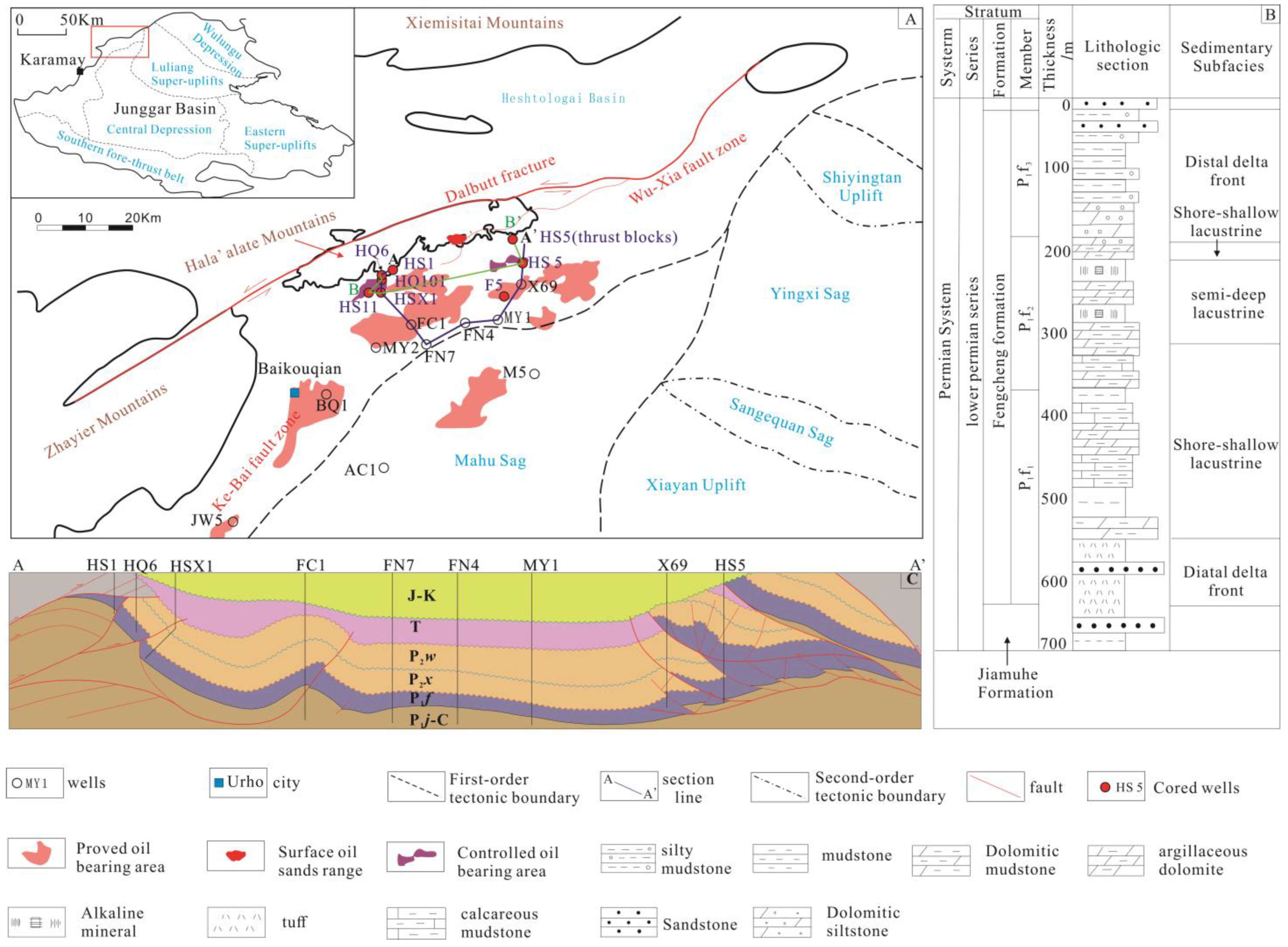

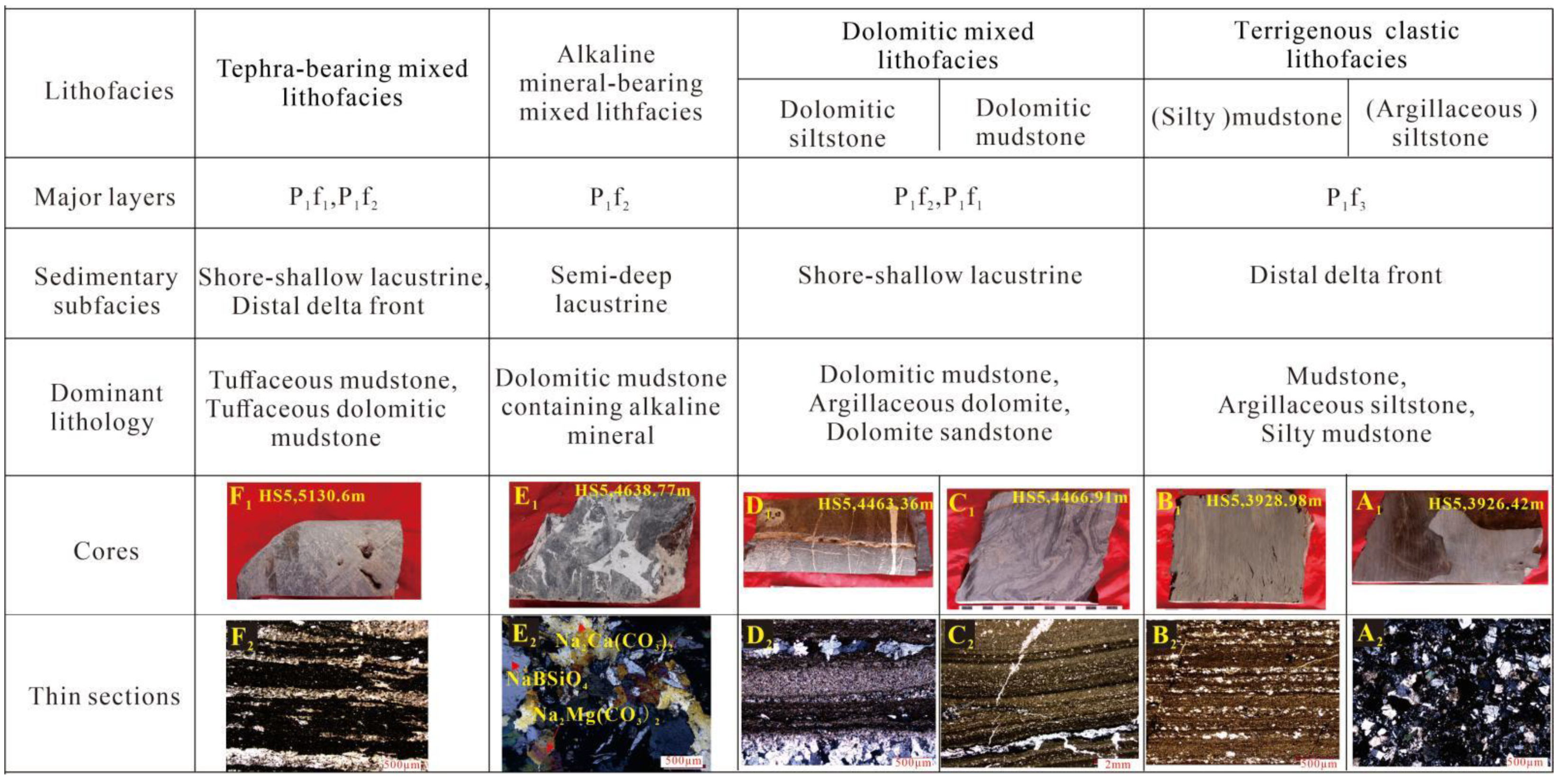
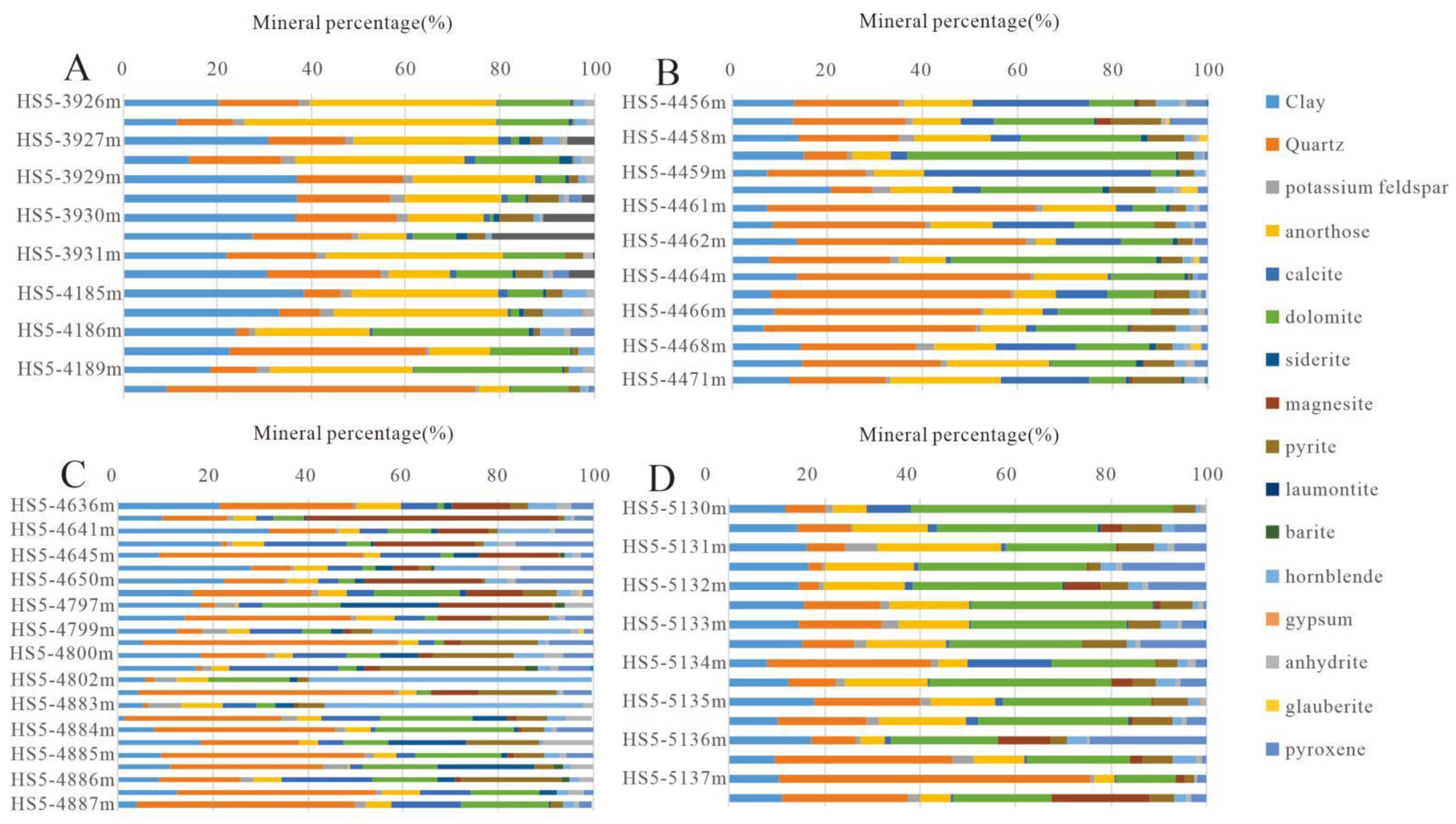
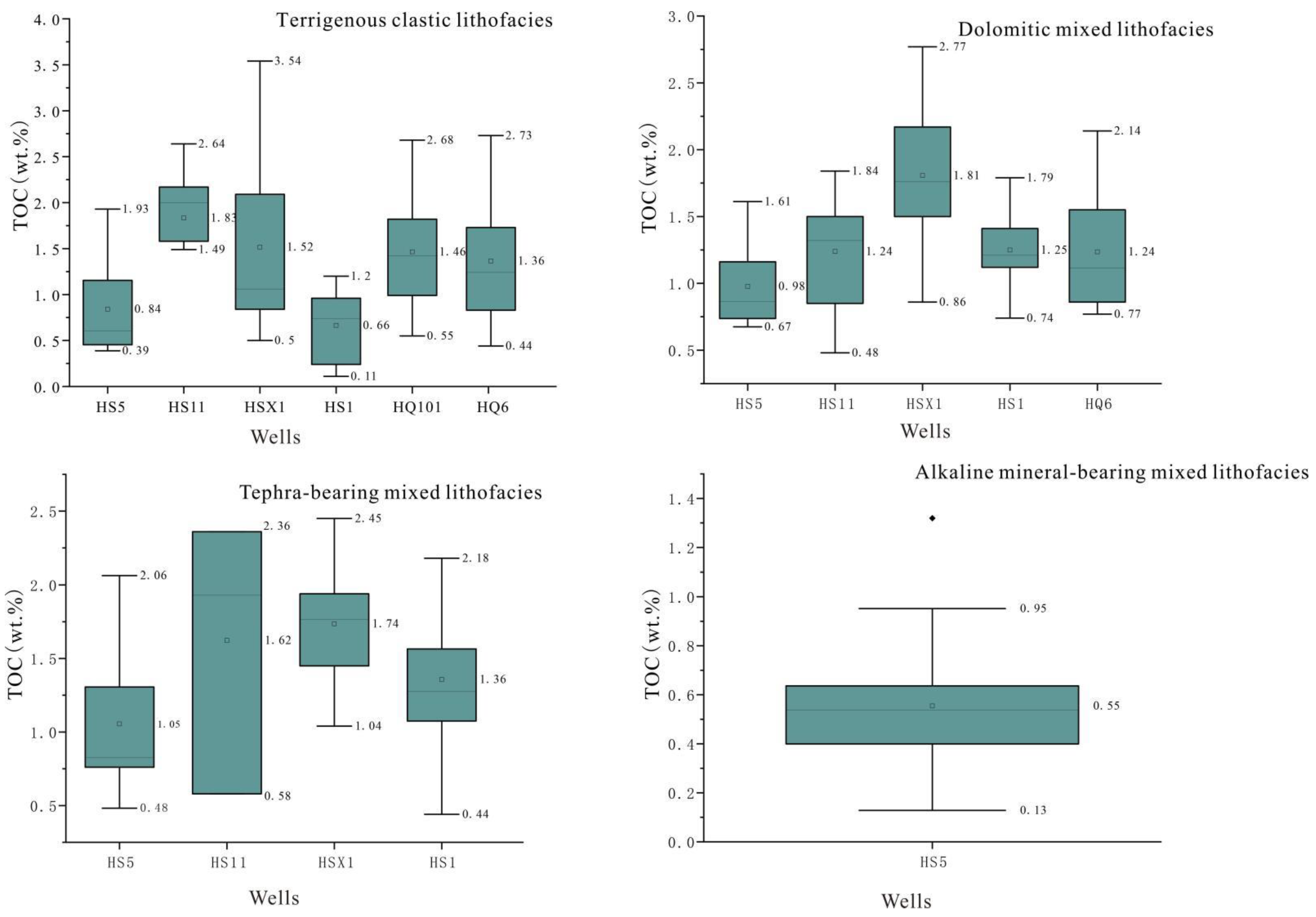

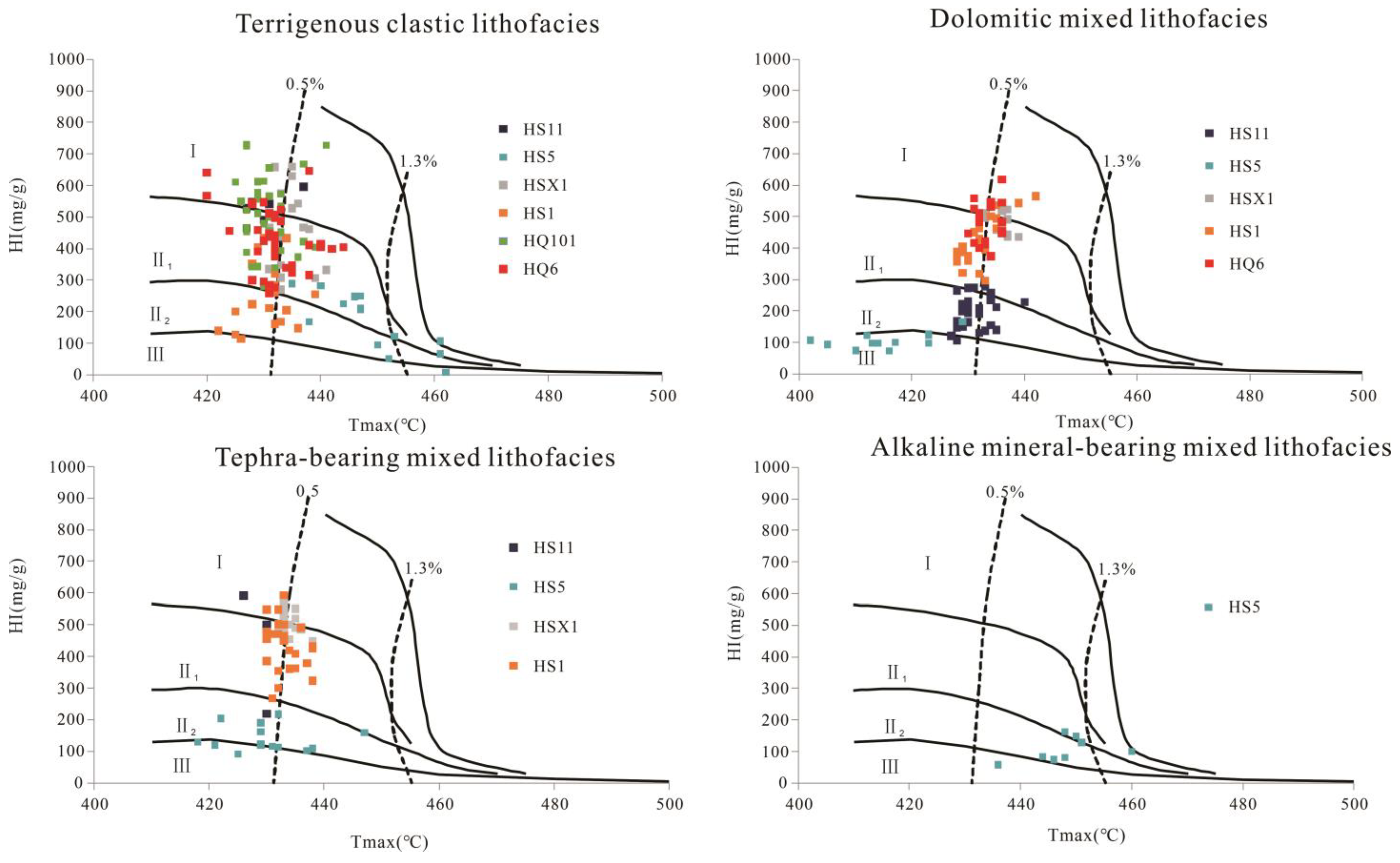




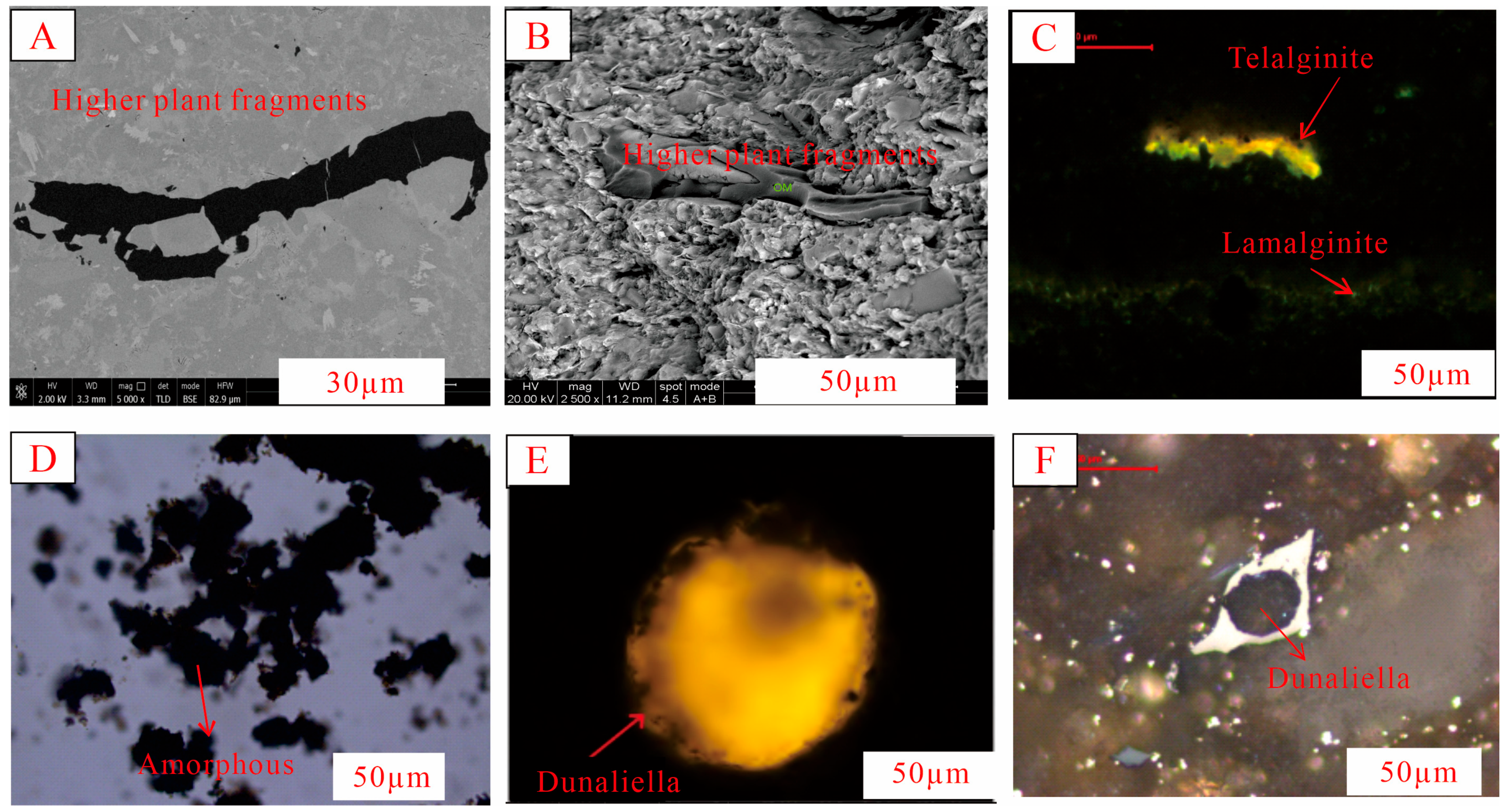
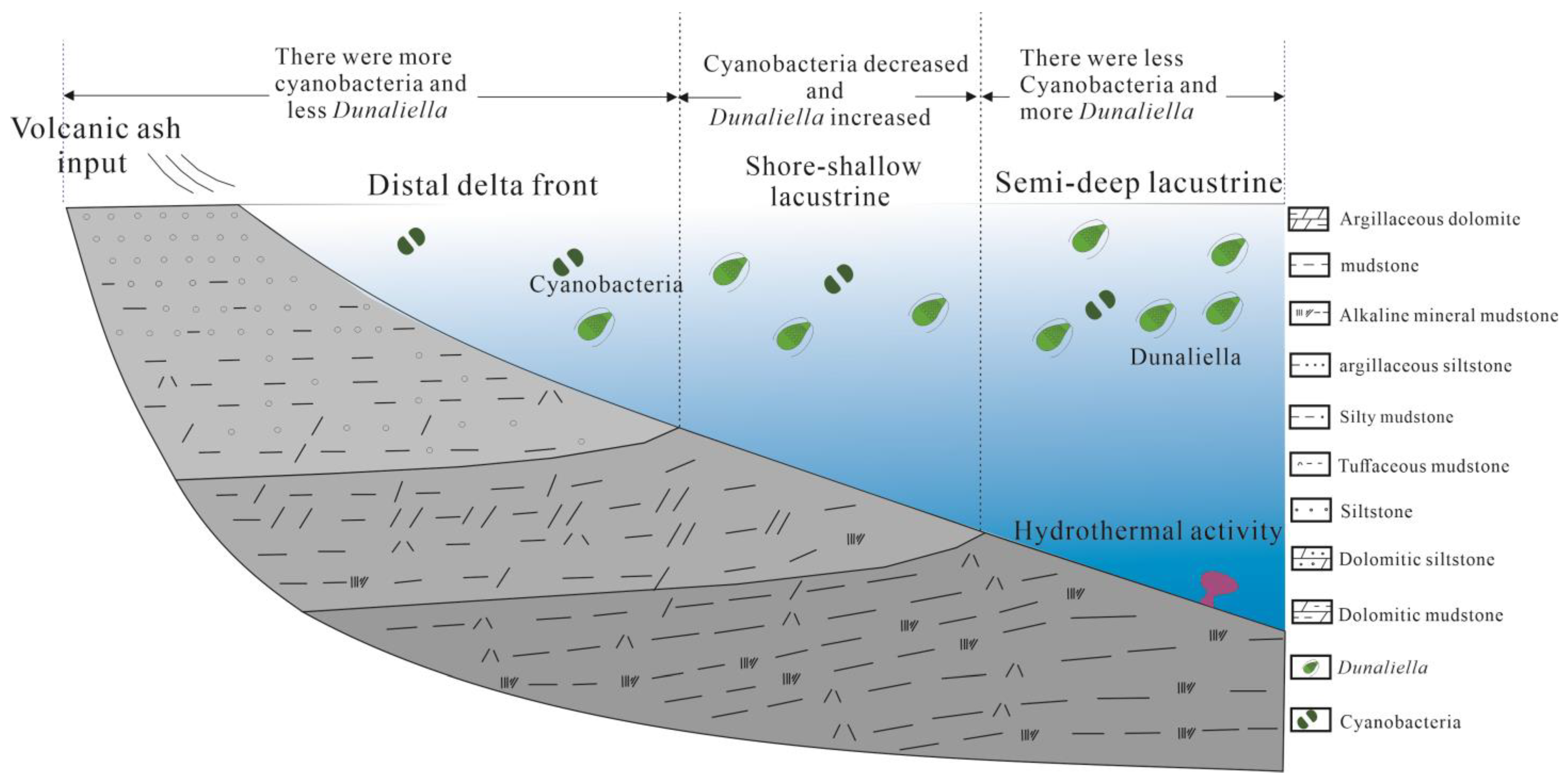
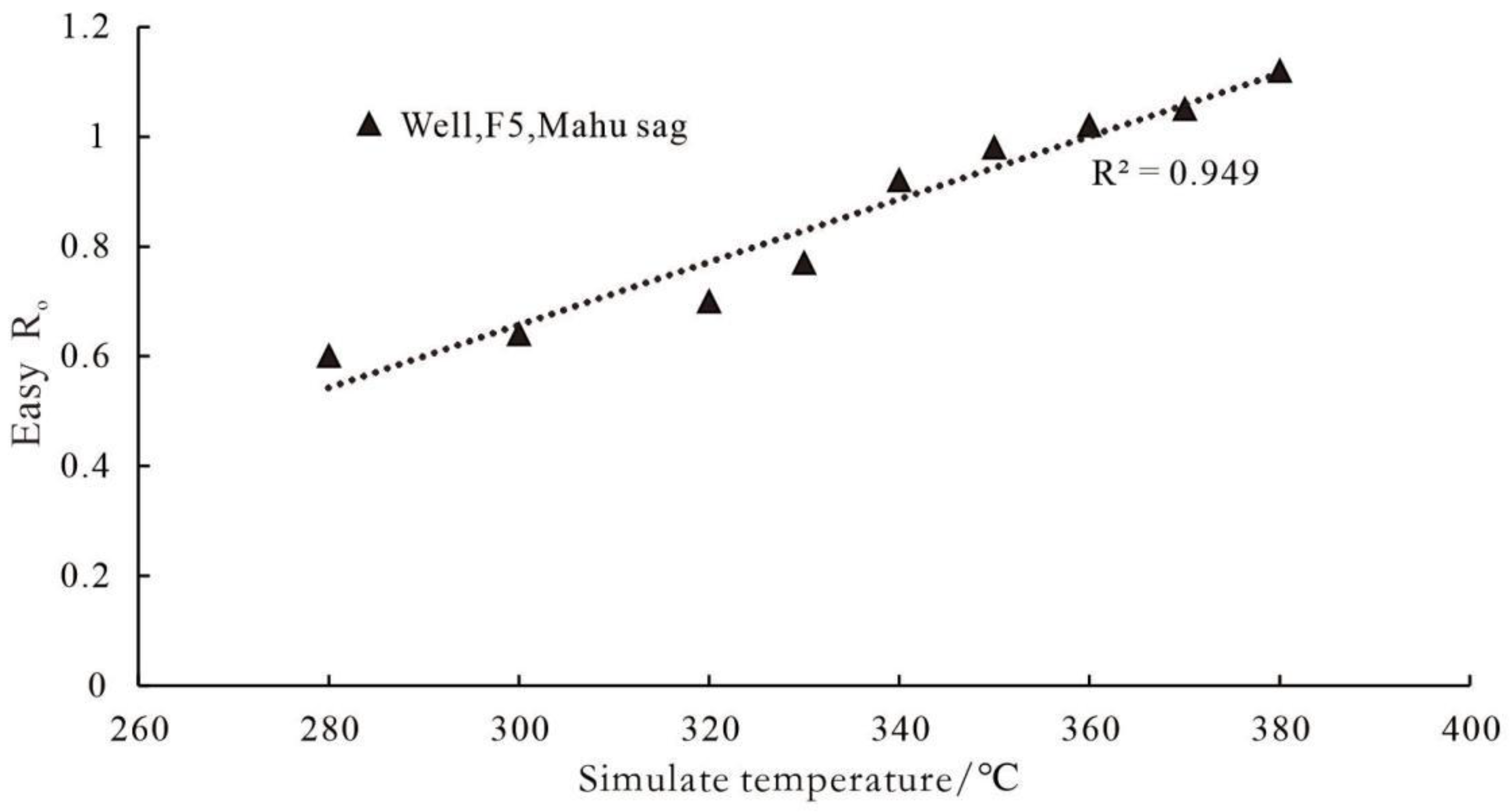
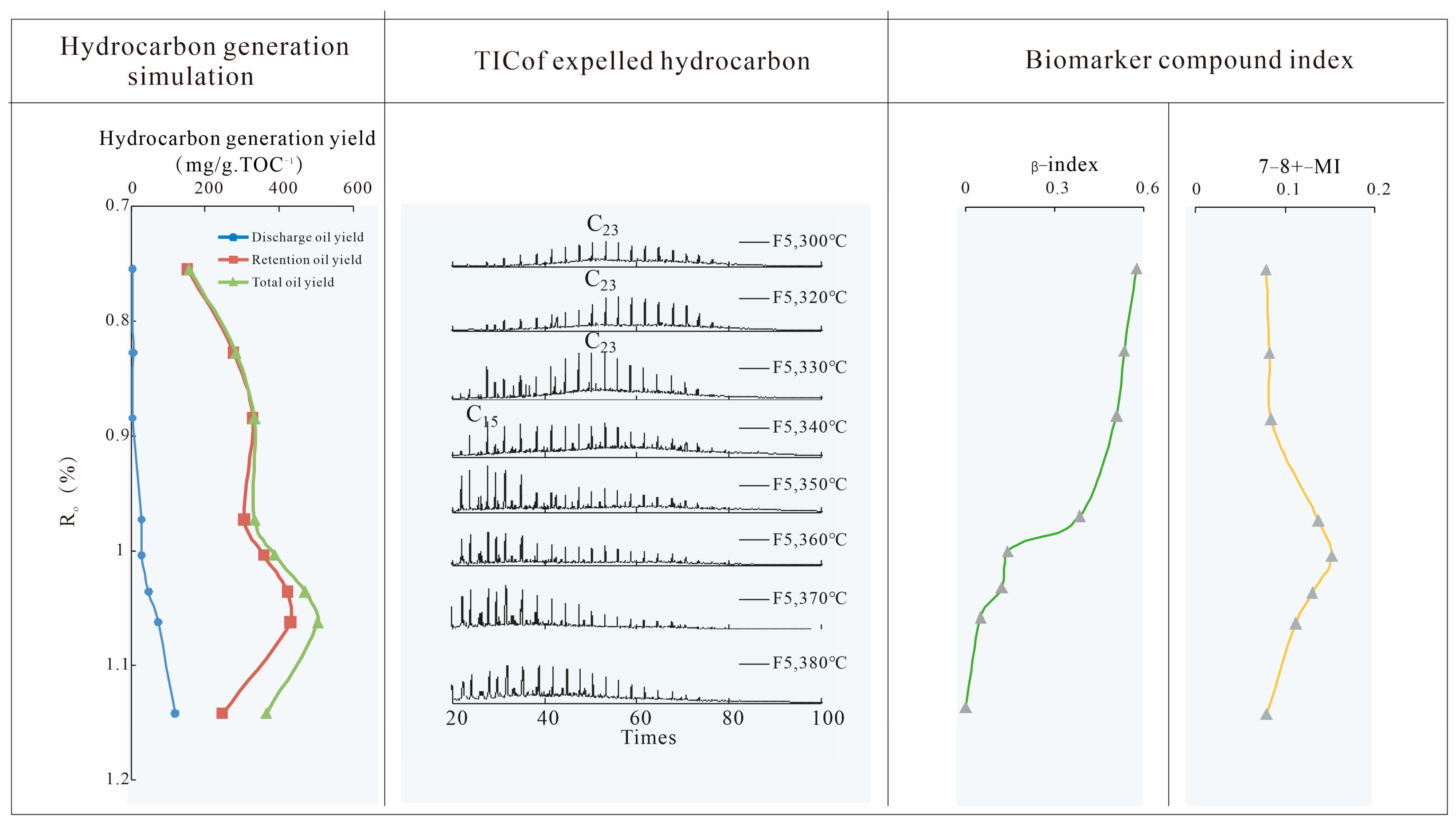
| Sedimentary Facies | Lithofacies | Lithology | Depth (m) | Sapropelite (%) | Vitrinite (%) | Inertinite (%) | Exinite (%) | Solid Asphalt (%) |
|---|---|---|---|---|---|---|---|---|
| Distal delta front | Terrigenous clastic lithofacies | Argillaceous siltstone | 3924.9 | 0 | 18.4 | 6.1 | 75.5 | |
| Silty mudstone | 3927.31 | 0 | 81.4 | 10.7 | 7.9 | |||
| Mudstone | 3929.28 | 47.6 | 28.7 | 10.8 | 6.7 | |||
| Mudstone | 3930.24 | 46.3 | 28.3 | 14.1 | 3.8 | 7.5 | ||
| Shore-shallow lacustrine | Dolomitic-mixed lithofacies | Dolomitic mudstone | 4455.95 | 5 | 61.1 | 30.2 | 8.7 | |
| Dolomitic mudstone | 4470.15 | 0 | 74.5 | 17.6 | 0 | 7.9 | ||
| Shore-shallow lacustrine | Tephra-bearing mixed lithofacies | Tuffaceous mudstone | 5130.75 | 0 | 67.5 | 20 | 5.6 | |
| Tuffaceous dolomitic mudstone | 5131.69 | 0 | 61.7 | 24.4 | 3.5 | 10.4 | ||
| Semi-deep lacustrine | Alkaline mineral-bearing mixed lithofacies | Dolomitic mudstone containing alkaline mineral | 4642.8 | 0 | 66.3 | 16.9 | 0 | 16.8 |
| Dolomitic mudstone containing alkaline mineral | 4645 | 0 | 48.5 | 27.3 | 0 | 24.2 |
| Wells | Depth(m) | Formation | Lithology | TOC (%) | S1 (mg/g) | S2 (mg/g) | HI (mg/g) | Ro (%) |
|---|---|---|---|---|---|---|---|---|
| F5 | 3221.45 | P1f | Black mudstone | 1.53 | 1.36 | 7.69 | 501 | 0.69 |
Disclaimer/Publisher’s Note: The statements, opinions and data contained in all publications are solely those of the individual author(s) and contributor(s) and not of MDPI and/or the editor(s). MDPI and/or the editor(s) disclaim responsibility for any injury to people or property resulting from any ideas, methods, instructions or products referred to in the content. |
© 2025 by the authors. Licensee MDPI, Basel, Switzerland. This article is an open access article distributed under the terms and conditions of the Creative Commons Attribution (CC BY) license (https://creativecommons.org/licenses/by/4.0/).
Share and Cite
Sun, Z.; Li, Z.; Zhang, K.; Song, Z.; Yu, H.; Wang, B.; Song, M.; Cao, T. Classification Evaluation and Genetic Analysis of Source Rocks of Lower Permian Fengcheng Formation in Hashan Area, Junggar Basin, China. Minerals 2025, 15, 606. https://doi.org/10.3390/min15060606
Sun Z, Li Z, Zhang K, Song Z, Yu H, Wang B, Song M, Cao T. Classification Evaluation and Genetic Analysis of Source Rocks of Lower Permian Fengcheng Formation in Hashan Area, Junggar Basin, China. Minerals. 2025; 15(6):606. https://doi.org/10.3390/min15060606
Chicago/Turabian StyleSun, Zhongliang, Zhiming Li, Kuihua Zhang, Zhenxiang Song, Hongzhou Yu, Bin Wang, Meiyuan Song, and Tingting Cao. 2025. "Classification Evaluation and Genetic Analysis of Source Rocks of Lower Permian Fengcheng Formation in Hashan Area, Junggar Basin, China" Minerals 15, no. 6: 606. https://doi.org/10.3390/min15060606
APA StyleSun, Z., Li, Z., Zhang, K., Song, Z., Yu, H., Wang, B., Song, M., & Cao, T. (2025). Classification Evaluation and Genetic Analysis of Source Rocks of Lower Permian Fengcheng Formation in Hashan Area, Junggar Basin, China. Minerals, 15(6), 606. https://doi.org/10.3390/min15060606






